F.W. Woolworth opens in Germany, 1927
The early origins of the Woolworth survivor:
'since 1879' ... re-imagined, re-born and revitalized
and expanding rapidly in Germany and beyond
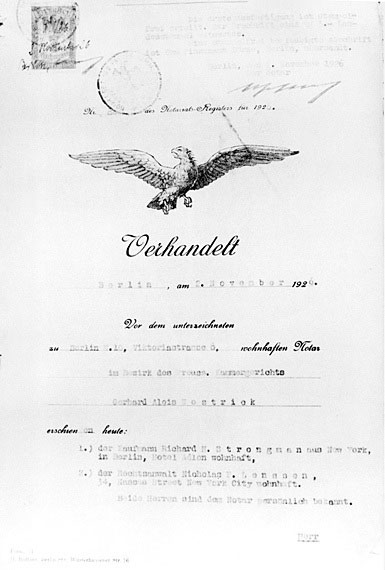
Frank Woolworth first discovered the wonders of Germany on a Buying Trip in 1890. He ordered dolls from Sonneberg and lots of Christmas Decorations from the villages of Eastern Germany. In the negotiation he had persuaded some toy and decoration makers to sell to him direct, and had agreed to pay cash for the goods as soon as they were produced, at any time of year.
By 1900 the firm had a substantial operation in Sonneberg which collated and packed the goods for the long journey back to New York. By 1914 25% of the goods sold in the North American stores were European-made. Frank was in Paris on a buying trip when war broke out and knew at once it would be hard to get home and harder to fill the shelves of the 5 & 10¢.
As U-boats brought transatlantic traffic to a halt, Woolworth helped US factories to replicate his best European items.
By the time of Frank Woolworth's death in 1919 transatlantic trade had been restored, and was already soaring towards pre-war levels. New leaders followed the same principles. A reorganisation moved Byron Miller, who had been a Director of the British subsidiary back to New York, where he became Treasurer (FD) and the VP responsible for international operations.
The 1924 Dawes Plan strengthened economic ties between the US and Weimar Germany. Miller toook this as his cue to expand the sourcing operation in Germany. He secured funds to build a huge new warehouse in Sonneberg, complete with its own train station. He later supported a proposal by fellow executive Richard Strongman for a consolidated German subsidiary with shops of its own. The papers were signed in Berlin on 2 November 1926.
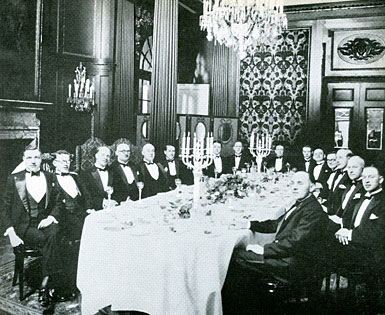 The Sonneberg operation gave Woolworth a strong foothold in Germany. It employed both Americans and local people to choose products for its stores in the USA, Canada, Cuba, Great Britain and the Irish Free State. The decision to open stores added a new dimension, prompting the Buyers to add household necessities to the luxuries and novelties which they had traditionally purchased from factories across Europe.
The Sonneberg operation gave Woolworth a strong foothold in Germany. It employed both Americans and local people to choose products for its stores in the USA, Canada, Cuba, Great Britain and the Irish Free State. The decision to open stores added a new dimension, prompting the Buyers to add household necessities to the luxuries and novelties which they had traditionally purchased from factories across Europe.
By the 1920s the 5 & 10¢ formula had already endured for over forty years. Other dimestores had already traded up to add 15¢ and 20¢ lines, while Woolworth had stuck with its Founder's principles At the launch of the British subsidiary '5¢ and 10¢' had become '3 and 6 pence', which was a little higher. Richard Strongman and his team decided to go further, choosing '25 and 50 Pfennigs', or about twice rate in the UK and three times the limit in the USA. This was enough for a broader selection of products, including a range of clothing and fashion.
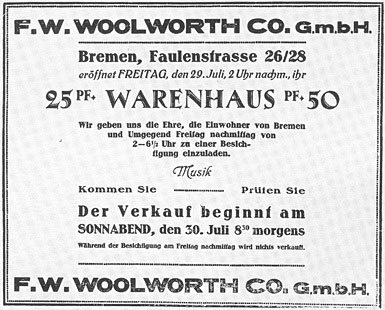
When it came to siting their stores, the German Board drew on Miller's expertise. In 1909-10 he had learnt from the Founder and had negotiated some of the first British leases. The formula had taken hold much quickly than across the Atlantic. In its first five years the UK operation had grown to 44 stores. In the same period the 5 & 10¢ had established only five.
The Northern coastal City of Bremen became home to the first F. W. Woolworth Co. GmbH store. The selection mirrored the British pattern. In the UK the North West seaport of Liverpool had become 'ground zero'. There were other parallels too. A preview was held on the Friday afternoon before opening. Local VIPs and the media joined shoppers for an inspection, and were entertained by an orchestra and given refreshments. The store opened for business at 8.30am the following morning.
As the pictures below illustrate, the early German stores faithfully presented the established Woolworth brand and store look. For example in Bremen the layout and atmosphere was virtually identical to the UK store in Maldon, Essex which opened at around the same time, though the merchandise on the counters was distinctly different between the two stores.
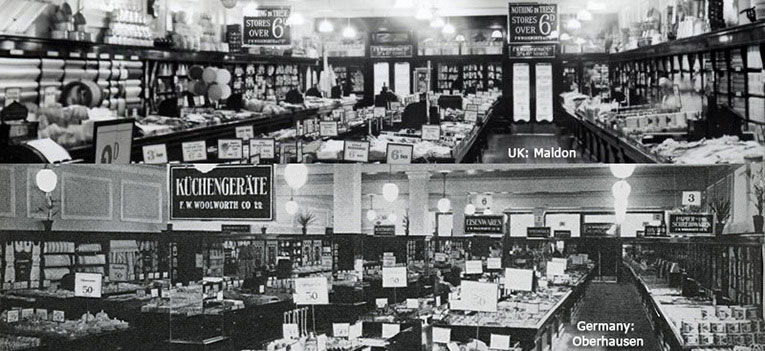
The German opening helped to confirm the New York parent company as the first global Retail Brand. The Woolworth look, which had taken shape as part of $65m merger in 1912, was already consistently applied across the USA and (adjusted for Canadian-French speakers as appropriate) throughout the former S.H. Knox and E.P. Charlton stores to the east and west of the Rockies. It had been successfully translated for the English stores in 1909, spreading to Scotland and Wales in 1913 and Ireland in 1914.
In 1928 progress accelerated. The new Bremen store was quickly joined by branches in Offenbach, Brilon and Heiligenhaus en-route to Berlin. With the exception of the small GmbH suffix and the local currency on the fascia, the look matched sister stores in seven countries spread three thousand miles across the globe.
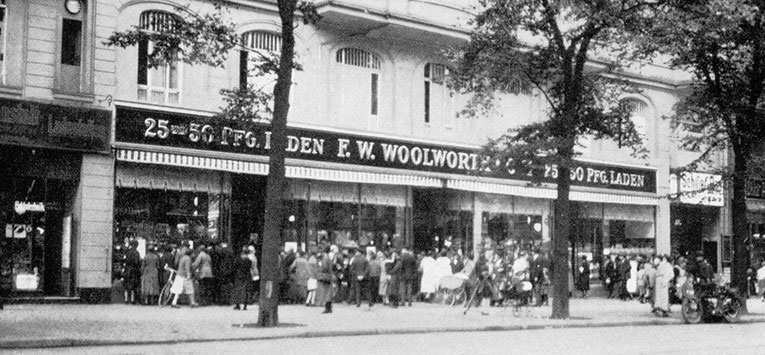
The opening was well timed. In the mid 1920s Germans had developed a great love for all things American. The United States was seen as ultra-modern. Its culture set Berlin's trends and fashions. Local people flocked to Woolworth's and filled the cash registers with pfennigs and deutchsmarks. By the end of 1927 the German company had seven stores, including one in Berlin. The profit generated was used to finance further openings. The American Founders engaged and trained local people to create a self-sustaining formula. By 1934 the chain had grown to eighty two stores, balancing prime City centre locations large enough to rival the department stores, and smaller outlets geared to the needs of rural communities and small towns.
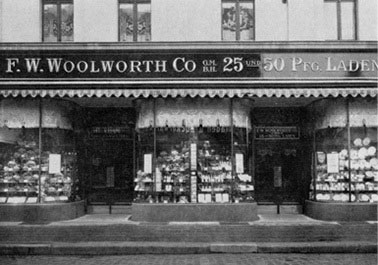
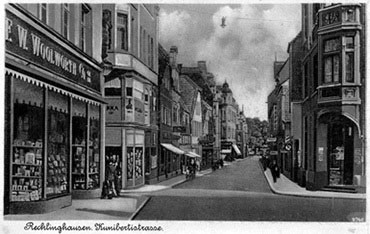
In 1932 the American parent company increased its upper price limit from 10 to 20 cents. Executives did not suggest a change to the fifty pfennig maximum in Germany but they did recommend that it would be prudent to amend the fascias of future stores to drop the prices. The space was filled by the 'Diamond W' logo.

During 1932 a frenzy of correspondence between the German company's headquarters in Bellevuestrasse, Berlin and 233 Broadway, New York, expressed concern at the changing political scene in Germany. Where five years earlier they had celebrated their 'American-ness', now they feared this was becoming increasingly unfashionable. The National Socialist Party had developed a strong following during the Economic Depression. They criticised the crippling reparations imposed by the Treaty of Versailles after the Great War. They also ridiculed the American-led Dawes Plan, that had brought an end to hyper-inflation in 1923-4 by loading the country with debt. They pointed out that the Wall Street Crash had hit German investors much harder than Americans. Woolworth executives reported anti-American sentiment and recommended that the chain should become 'more German'.

American executives struggled to find a response. They considered the brand to be neutral and their German subsidiary to be largely self-managing, recruiting and developing its own people. They also struggled to understand anti-American sentiment at a time when they were investing heavily in the German economy, not only through the store openings and the employment that they brought, but also by buying very large quantities of manufactured goods through the sourcing operation in Sonneberg. The local management was given a degree a discretion, but with no clear understanding in New York of how this would manifest itself or why it was needed.
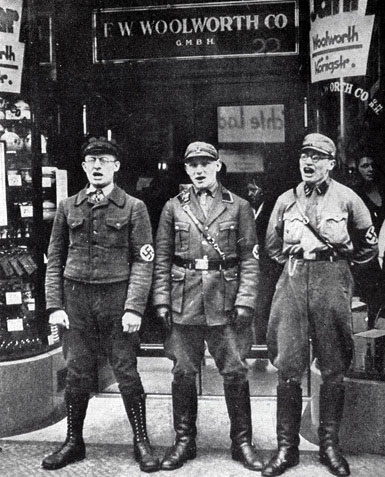
Weeks later shocking pictures brought a rude awakening in New York. American Newspapers carried images of SA soldiers picketing the German stores. The editorial and captions called these men 'Hitler's storm troopers' and caused great concern for stateside investors and associates. A war of words followed.
The pickets complained that members of the American management were Jewish. The offices in New York and Berlin issued statements denying this. The press releases explained that while anyone could own shares in a public company, the Chairman of the Board, Charles Sumner Woolworth, was a Methodist. The family could trace its roots to the Pilgrim Fathers.
In fact some other senior American executives had faced quite the opposite criticism. An ugly streak of anti-Semitism had long been suspected and denied. Early Perry ('Chuck') Charlton, the grandson of one of the Company's Founders and himself a Woolworth Executive, observed in his book 'The Charlton Story' that the former Charlton Superintendent, Simon Kapstein, was dismissed from the management of the San Francisco store because "New York office had decided the decided that they didn't want a Jew to manage one of the largest stores in the United States". A footnote attributes the remarks to Kapstein's unpublished autobiography.
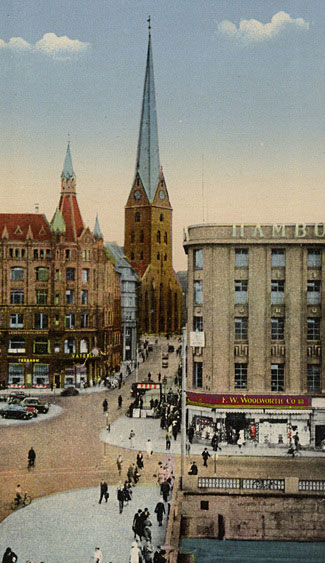
In the months that followed new laws were passed that were intended to protect local industry and curtail the power of foreign corporations. The legislation prevented overseas firms for taking the profits they made in Germany out of the country, and placed constraints on the way subsidiary companies were supervised. As a result New York was forced to give its Berlin office a far greater degree of autonomy. It rose to the challenge, proving that the seven-year old company had already laid strong roots.
Little is known about the settlement that ended the picket, but a surviving New York cinema travelogue, which was made in 1936 to mark the Berlin Olympics, includes a sequence with a narration that starts out "Here is a familiar site from home" before describing the fine selection of "Adolf Hitler tea sets for 50 Pfennigs - complete" in a Berlin Woolworth's windows.
New York executives were frustrated by the interruption of their links to Berlin. By 1938 the balance sheet omitted $1,992,399.27 in unrealized dividends from the venture. German turnover would have taken sales over the $1 billion mark that year. The Annual Report held out the hope that the political situation in Germany would soon be 'resolved'.
When it came, the 'resolution' had its share of irony. The Germans had used the giant Sonneberg facility as an arsenal, hoping that its American roots would protect it from aerial bombardment. It was razed to the ground in 1945, and was never rebuilt.
Many of the stores faced a similar fate. Sixty-six of eighty-two branches, accounting for over 80% of the trading space were destroyed mainly in 1944 and 1945. This level of destruction far outweighed the impact of the blitz in Britain, where just 6% was lost. Bomber Command argued that the bombardment helped to end the war more quickly.
The chain's recovery after World War II became legendary in the USA. The German subsidiary became the new wonder-child. It was cited extensively to stateside executives as an example of triumph in adversity. Associates were amazed by a steady stream of news, as it was reported that the branches had been restored and regenerated. The new-look company established new markets for clothing, fashion and higher-priced merchandise. Cousins in the USA, Canada, Great Britain and Ireland struggled to achieve the same result. The German Woolworth comfortably made the transition to modern department stores and smaller convenience stores. It enjoyed great success in the 1950s and early 1960s, before executives in New York became distracted by diversification and expensive initiatives like the Woolco.
Between 1970 and 1997 profits from Germany helped to sustain the parent company. The Americans tried in vain to copy the successful German formula, but failed to do so. They left the European stores largely unchanged as they concentrated on problems at home. After years of under-investment and missed opportunities, the Directors decided to end their attempts to update the Five-and-Ten chain in North America, progressively closing every store between 1992 and 1997, until just the German subsidiary remained. This was sold to a private equity group as the parent relinquished control after seventy years.
Today after some traumas during the credit crunch, the brand has been restored. Today it is much closer to the founding principles that established Frank Woolworth as a Merchant Prince. Its 620 German stores - an all-time high - offer incredible value on a range of around 10,000 items, around 90% of which are own-brand and designed to the Company's own specification. All are exceptional value for money. The young and dynamic, self-sustaining team has plans to open around 100 stores a year in Germany, and aims to expand right across Europe. It believes that one day the Continent could have as many as 5,000 Woolworth stores. As you will see on our home page, the Company recently acquired the rights to trade in those European countries which it did not previously hold, after acquiring them from Very Group Ltd. Those rights include the option to open stores or other ventures in Great Britain and Ireland. Its dynamic boss, Roman Heini, recently told Retail Week that his pipe dream for the medium-to-long term is to re-open High Street shops in the UK, where the brand still has remarkably high, spontaneous recognition with the public, and where he believes the updated formula would be a big hit with families and home-builders. The Woolworths Museum wishes him every success in bringing that dream to life.
Give or take a handful of continuing branches with different affiliations in Zimbabwe, Barbados and Mexico, it now falls to the Germans to continue the heritage and tradition of store retailing that Frank Woolworth first established in Lancaster, Pennsylvania in 1879. One thing is for sure. He would feel at home in the shops, and be impressed by the super-efficient supply chain and administration centre recently established in Unna, which provides a great engine for growth, and the dynamic team that is developing the leaders it needs for a rapid expansion programme. You can find out more about the German company, in either English or German, via the links in the top menu on every page of the Museum. It's well worth a visit, and great once again to have a Museum about a brand that's growing rapidly rather than just preserving something from a bygone age!
Shortcuts to related content
1920s Gallery
"The Girl from Woolworths" movie
Down under and the sincerest form of flattery
Site navigation